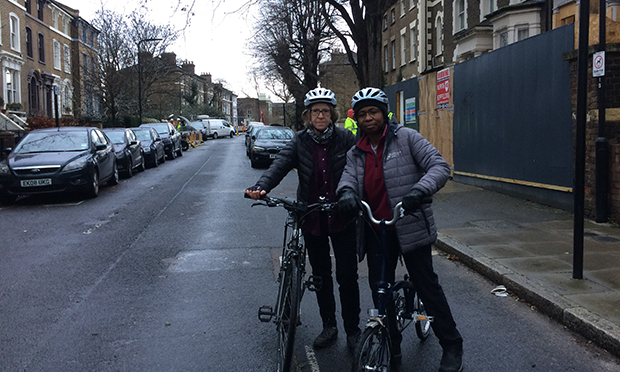LTNs: ‘The policy is environmentally unjust’

Photograph: courtesy Clair Battaglino
I don’t own a car. I walk, I cycle, and in earlier times happily took public transport. I recycle, grow my own vegetables, home compost and coordinate a local community garden. So, when I heard about Hackney’s post-lockdown green agenda, I didn’t pay any attention to the detail. I knew it would be something I’d support wholeheartedly.
How wrong I was! I managed to escape London for a few weeks in September and when we returned home, my partner and I noticed immediately that something was wrong. The road in front of our home was a never-ending line of stationary and slow-moving vehicles in both directions – all day, every day. The house smelled and even tasted like exhaust fumes.
We assumed it was temporary roadworks or some other hiccup but a week later we realised that it was the implementation of a Low Traffic Neighbourhood (LTN) that had caused this new reality.
Our home had very quickly become Dante’s ninth circle of hell. How could the council claim they were restricting traffic on “residential roads” when we live on a residential road and we were experiencing a threefold increase in traffic, including many more HGVs as well as stationary or slow-moving tailbacks for most of the day?
Though an odd mix of estates and historic Georgian residences, Dalston Lane has a very high proportion of social housing, including two buildings specifically for older residents and other supported housing. We have a nursery and a primary school, the latter with one of the borough’s most disadvantaged intakes.
Surely, this could not be happening to us under a Labour council? How could the Town Hall restrict traffic on Richmond and Middleton Roads whilst claiming that traffic was being funneled onto “roads that could take it”? What a nonsense!
Dalston Lane predates motor cars and quite possibly contains more listed buildings than any other road in Hackney. We also have more people living here than on those other roads, but we now have never-ending congestion day and night. Why have we become collateral? Despite arguments to the contrary, the situation on Dalston Lane is not the result of roadworks or changes to signals, and it has not “settled down”. There is no let-up.
Claims that traffic on roads outside of LTNs has not increased is a case of being economical with the truth. The roads monitored were not the roads causing concern and road monitors do not count cars that are not moving. But my lungs do!
On a personal note, by the end of October, my partner, who is asthmatic but never used an inhaler at home, was waking up gasping for air. My own mild chronic obstructive pulmonary disease (COPD) has progressed to the point where my GP had to prescribe an inhaler and a peak flow meter, so I can self-monitor the deterioration in my lung capacity. These arrived in the post on my birthday and I burst into tears. We have both asked our doctors to note that the decline in our lung health is a direct result of the impact of LTNs on our residential road. It is hard to face each day knowing that where you’ve lived for 35 years is killing you.
Countless emails to councillors and the mayor have gone unanswered. Videos of children and parents from Mossbourne fighting traffic at home-time have been met with a lack of interest that I find astonishing. One councillor even said they were happy with the London Fields LTN because there is now a bit less traffic when they walk their daughter to nursery. I am almost at a loss for words.
And the LTNs? They don’t help me cycle more safely and they don’t go anywhere I particularly want to cycle. They take a small amount of traffic from leafy residential roads and put it on other residential roads, making things extremely unhealthy for those who live and go to school on these roads. They make it more dangerous for cyclists using these roads with the knock-on effect that more cyclists now ride on the pavement, making it dangerous for pedestrians.
Roads like Dalston Lane are thoroughfares for people using public transport and shopping. The creation of these high-traffic corridors is making pedestrians breathe a higher level of pollution than ever before.
Hackney Council is not convincing me to try cycling, walk more, or give up the car I don’t own. LTNs disadvantage one group of residents as compared to another based on where we live and where we can afford to live.
The policy is environmentally unjust. It should be halted and reversed before more harm is done.
